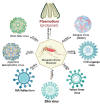Mechanism of Immune Evasion in Mosquito-Borne Diseases
- PMID: 37242305
- PMCID: PMC10222277
- DOI: 10.3390/pathogens12050635
Mechanism of Immune Evasion in Mosquito-Borne Diseases
Abstract
In recent decades, mosquito-borne illnesses have emerged as a major health burden in many tropical regions. These diseases, such as malaria, dengue fever, chikungunya, yellow fever, Zika virus infection, Rift Valley fever, Japanese encephalitis, and West Nile virus infection, are transmitted through the bite of infected mosquitoes. These pathogens have been shown to interfere with the host's immune system through adaptive and innate immune mechanisms, as well as the human circulatory system. Crucial immune checkpoints such as antigen presentation, T cell activation, differentiation, and proinflammatory response play a vital role in the host cell's response to pathogenic infection. Furthermore, these immune evasions have the potential to stimulate the human immune system, resulting in other associated non-communicable diseases. This review aims to advance our understanding of mosquito-borne diseases and the immune evasion mechanisms by associated pathogens. Moreover, it highlights the adverse outcomes of mosquito-borne disease.
Keywords: Rift Valley fever; West Nile fever; Zika; chikungunya; dengue; malaria; mosquito-borne diseases; virus.
Conflict of interest statement
The authors have no relevant financial or non-financial interest to declare.
Figures






References
-
- World Health Organization . Ethics and Vector-Borne Diseases: WHO Guidance. World Health Organization; Geneva, Switzerland: 2020.
Publication types
LinkOut - more resources
Full Text Sources

